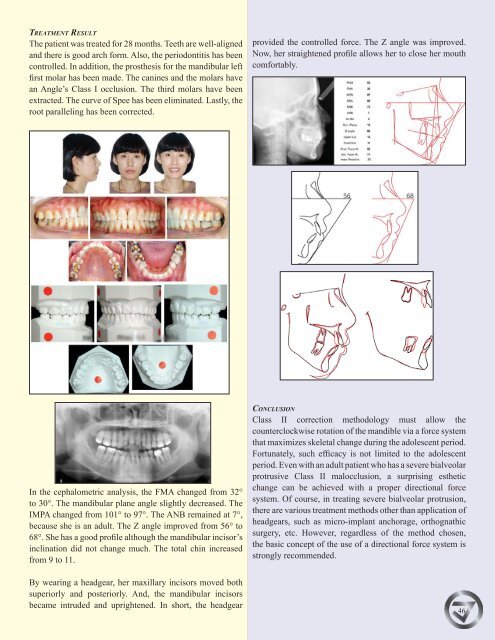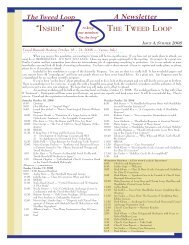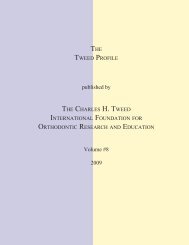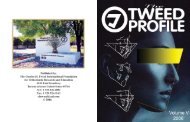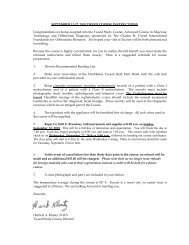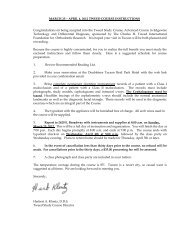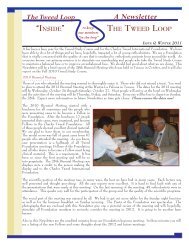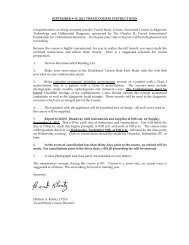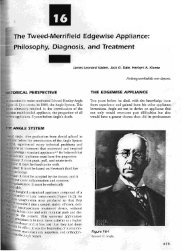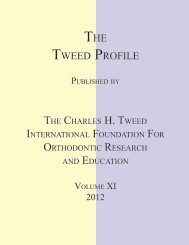the tweed profile - The Charles H. Tweed International Foundation
the tweed profile - The Charles H. Tweed International Foundation
the tweed profile - The Charles H. Tweed International Foundation
You also want an ePaper? Increase the reach of your titles
YUMPU automatically turns print PDFs into web optimized ePapers that Google loves.
TREATMENT RESULT<br />
<strong>The</strong> patient was treated for 28 months. Teeth are well-aligned<br />
and <strong>the</strong>re is good arch form. Also, <strong>the</strong> periodontitis has been<br />
controlled. In addition, <strong>the</strong> pros<strong>the</strong>sis for <strong>the</strong> mandibular left<br />
first molar has been made. <strong>The</strong> canines and <strong>the</strong> molars have<br />
an Angle’s Class I occlusion. <strong>The</strong> third molars have been<br />
extracted. <strong>The</strong> curve of Spee has been eliminated. Lastly, <strong>the</strong><br />
root paralleling has been corrected.<br />
provided <strong>the</strong> controlled force. <strong>The</strong> Z angle was improved.<br />
Now, her straightened <strong>profile</strong> allows her to close her mouth<br />
comfortably.<br />
In <strong>the</strong> cephalometric analysis, <strong>the</strong> FMA changed from 32°<br />
to 30°. <strong>The</strong> mandibular plane angle slightly decreased. <strong>The</strong><br />
IMPA changed from 101° to 97°. <strong>The</strong> ANB remained at 7°,<br />
because she is an adult. <strong>The</strong> Z angle improved from 56° to<br />
68°. She has a good <strong>profile</strong> although <strong>the</strong> mandibular incisor’s<br />
inclination did not change much. <strong>The</strong> total chin increased<br />
from 9 to 11.<br />
By wearing a headgear, her maxillary incisors moved both<br />
superiorly and posteriorly. And, <strong>the</strong> mandibular incisors<br />
became intruded and uprightened. In short, <strong>the</strong> headgear<br />
CONCLUSION<br />
Class II correction methodology must allow <strong>the</strong><br />
counterclockwise rotation of <strong>the</strong> mandible via a force system<br />
that maximizes skeletal change during <strong>the</strong> adolescent period.<br />
Fortunately, such efficacy is not limited to <strong>the</strong> adolescent<br />
period. Even with an adult patient who has a severe bialveolar<br />
protrusive Class II malocclusion, a surprising es<strong>the</strong>tic<br />
change can be achieved with a proper directional force<br />
system. Of course, in treating severe bialveolar protrusion,<br />
<strong>the</strong>re are various treatment methods o<strong>the</strong>r than application of<br />
headgears, such as micro-implant anchorage, orthognathic<br />
surgery, etc. However, regardless of <strong>the</strong> method chosen,<br />
<strong>the</strong> basic concept of <strong>the</strong> use of a directional force system is<br />
strongly recommended.<br />
46


